RECOIL OFFGRID Gear This Ain’t Your Daddy’s BB Gun?
In This Article
Picture the worst-case scenario. Our biggest threat (ISIS, Iran, al-Qaeda, North Korea — take your pick) has launched a coordinated series of suicide-bomb attacks in multiple metropolitan areas, hoping to spread fear and make the nation vulnerable to conventional attacks. Fortunately, you saw the writing on the wall and quickly bugged out in your off-road rig to the backcountry. You've lived off your emergency supplies, but weeks have now passed and you're barely surviving off the land.
You packed an AR-15 rifle, but are low on ammo; plus, using it to hunt could draw unwanted attention from other desperate souls. However, all your preparation for this type of scenario led you to bring along a fitting SHTF tool — an air rifle.
Many airguns available today are more than adequate for taking small- to medium-sized game. In the United States, they're even more attractive because they aren't heavily regulated. So, those of you who like to plan for any inevitability might consider keeping one in your rig or bug-out vehicle, as they can be more than useful in all sorts of emergencies — from being lost in the backcountry to facing long-term survival situations in no man's land.

First things first: what is an airgun? Think of it as a blowgun on steroids. Basically, it's like any firearm with a lock, stock, and barrel, except it uses compressed gas to propel the projectile. The breech has a close tolerance to the pellet, forming a seal to trap the air behind it. The trigger system either strikes a valve to release the compressed gas, or releases a spring/gas ram to push a piston that forces the air to compress and drive the pellet at the time of firing.
Airguns have been around for centuries, with fine examples being displayed in arms museums around the world. Even the Lewis and Clark Expedition carried a multi-shot air rifle on their famed trek west of the Mississippi in the early part of the 19th century. When they hear the term airgun, most folks immediately think of “BB gun.” While BB guns qualify as a type of airgun, the variants we're referring to are on a very different end of the spectrum. BB guns use .177-caliber steel shot and feature a smooth bore. While you could down a sparrow with a well-placed shot at close range, a shot from a BB gun is fairly anemic in most circumstances.
Quality air rifles utilize rifled barrels, with higher-end models sometimes sporting barrels made by top firearm barrel manufacturers such as Lothar Walther. Most fire .177- or .22-caliber pellets, and many come equipped with permanently attached sound moderators so their firing signature is less likely to announce your presence every time you go hunting. Would you believe that there are air rifles available today that are capable of taking out a buffalo at 150 yards? Don't believe it? Do a Google search to see for yourself. As astounding as that may seem, that's not even the extreme. In fact, back at the beginning of the 20th century, the U.S. Navy experimented with compressed air deck guns on a warship.
In a true SHTF scenario, could a modern air rifle be used for self-defense? Certainly, it is a possibility. However, there are caveats with that theory. First of all, a number of the air rifles discussed here are single-shot arms. While they may not be as slow to load as a muzzle-loader, they aren't rapid fire either. Another caveat is range. Unless you have a custom big-bore, your effective range will typically be less than 100 yards. Additionally, pellet mass is usually only between 7 and 15 grains, so there's not a lot of terminal ft-lb of energy hitting a target. The conclusion would have to be, yes, self-defense is a possibility in a pinch. But a better option would be to use your airgun for hunting, while saving your centerfire rounds for when you might really need them.
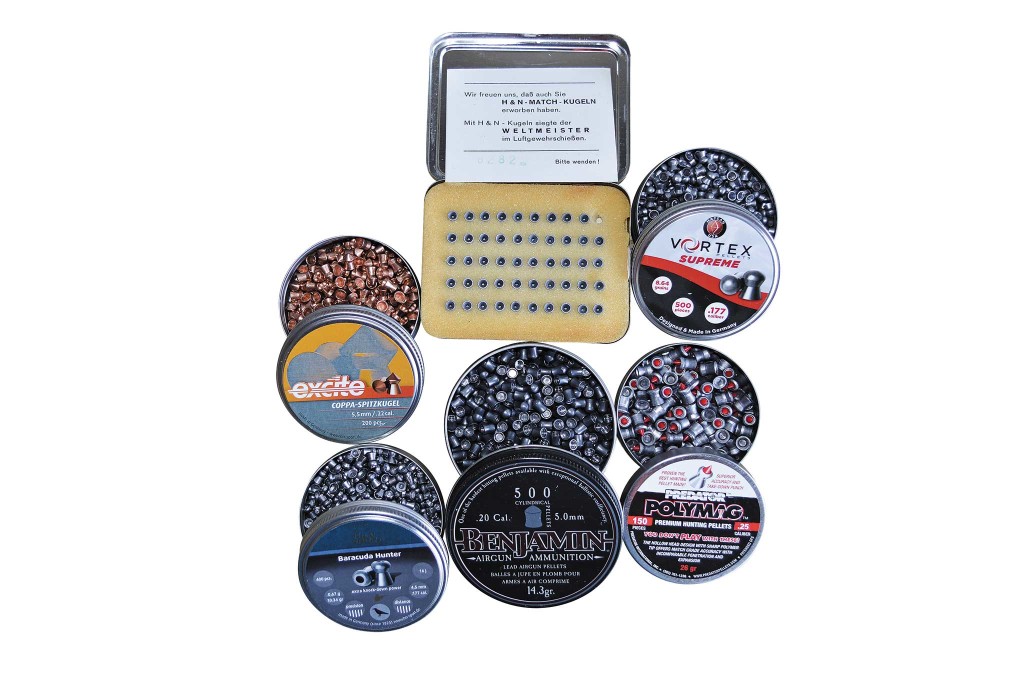
Affordable and abundant, airgun ammunition are pellets usually made from copper or lead. They come in various calibers,...
You've seen pellet rifles at the big-box stores, and most look like “starter” guns used to introduce kids to shooting. The low-end guns are excellent for that purpose, yet you wouldn't want to bet your life on them. If you're going to stake your survival on one, be sure to do your research. Let's look at the power plants providing the air or compressed gas to different types of airguns.
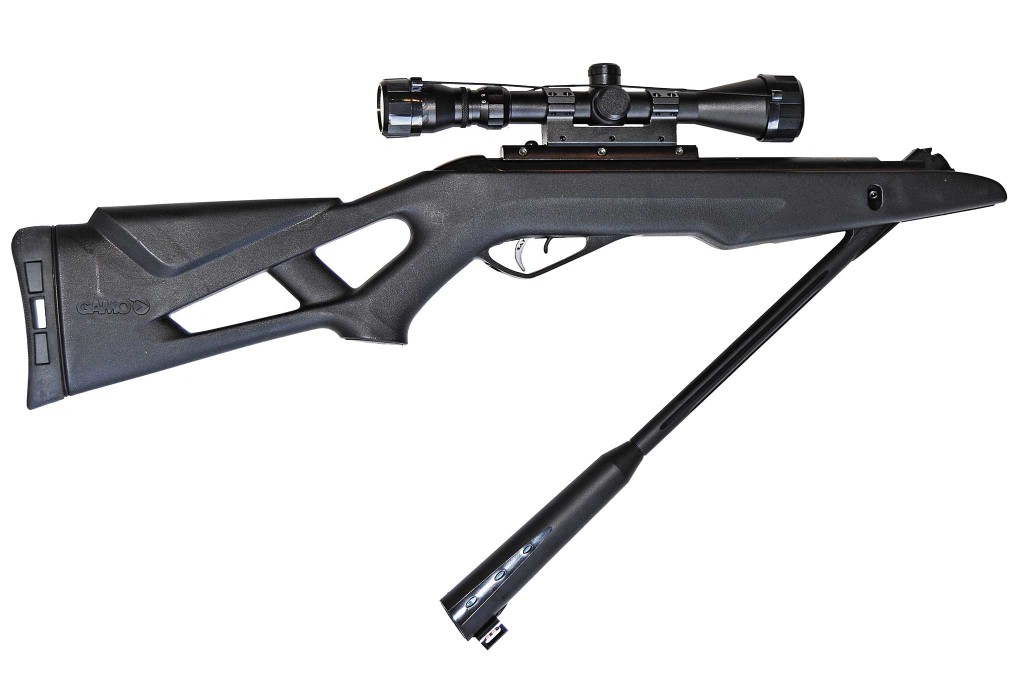
The Gamo Whisper Silent Cat is a spring-piston airgun of the break-barrel variety, meaning that the barrel also serves...
Spring-Powered: Spring-piston or gas-ram airguns are commonly referred to as “springers.” Break-barrel types are charged by forcing the barrel downward though the cocking arc, sometimes requiring up to 35 or 40 pounds of pressure. Then you load a pellet into the breech and return the barrel to its original position. Other versions of springers are charged by a side-lever or lever below the barrel.
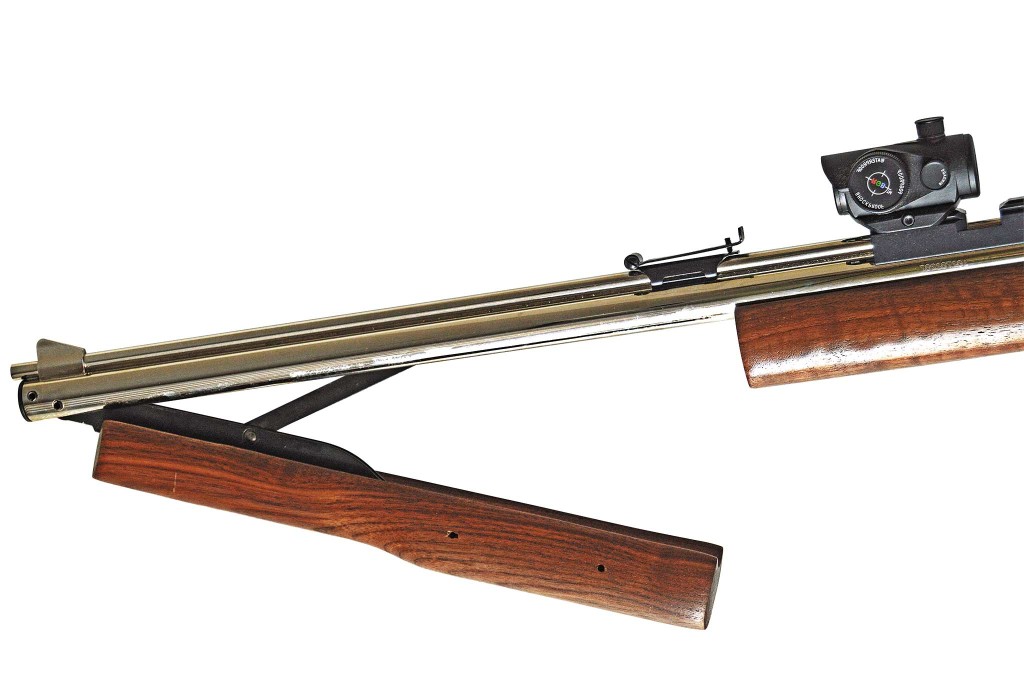
This Crosman Benjamin is a multi-pump air rifle, meaning its internal reservoir is charged by pumping a lever —...
Multi-Pump: These rely on an internal reservoir that is charged by pumping a lever, typically part of the fore-end of the rifle. When the rifle is fired, all of the air in the reservoir is released. This type allows the user to control the power and velocity of the shot to some extent by varying the number of pumps. Multi-pumps and powerful springers can be a real workout during long shooting/practice sessions, especially multi-pumps because each stroke is harder than the last.
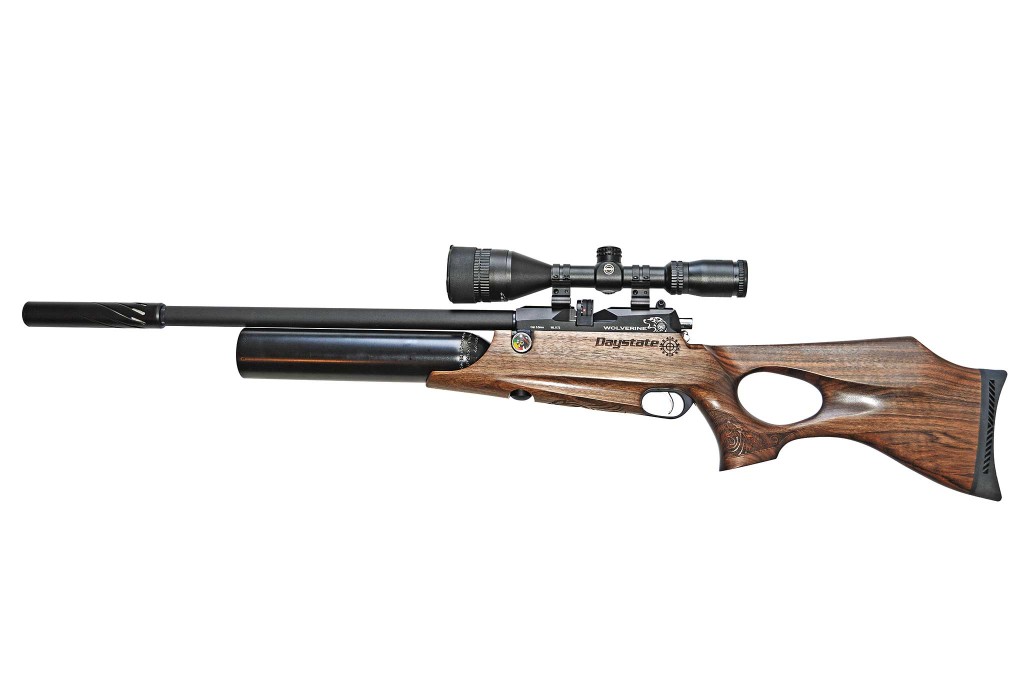
This Daystate Wolverine B can retail up to almost two G's. Your daddy's BB gun it is not — unless his...
Pre-Charged Pneumatic (PCP): These types hold high-pressure gas (air, CO2, or nitrogen), up to 3,000 psi, in a reservoir attached to the gun. PCPs can be good for many high-powered shots before needing recharging and can be stored under pressure for long periods of time (except in hot vehicles!). These might be considered a little less “self-contained” as they require either a specialized pump or some type of pressurized cylinder (i.e. scuba tank) to refill them. But, if your bug-out truck is already rigged with an air compressor, you won't have to worry about recharging when you're in the middle of nowhere.
Carbon Dioxide (CO2): CO2 airguns strictly run on pressurized carbon dioxide via throwaway cartridges or tanks. Newer models can take larger refillable 88-gram tanks as opposed to the little 12-gram cylinders commonly used in BB guns and with portable bicycle tire pumps. But note that those that accept the larger tanks are not going to be more powerful than the other types of airguns. A disadvantage to cylinder-fed guns is that carrying spare cartridges can get heavy really quickly. There are some PCP models that operate with either CO2 or high-pressure air that can be viable choices, only because you could revert back to air after exhausting your supply of CO2. Other drawbacks: pellet velocities are impacted by ambient temperature fluctuations that affect the gas cartridges, and they should not be stored pressurized.
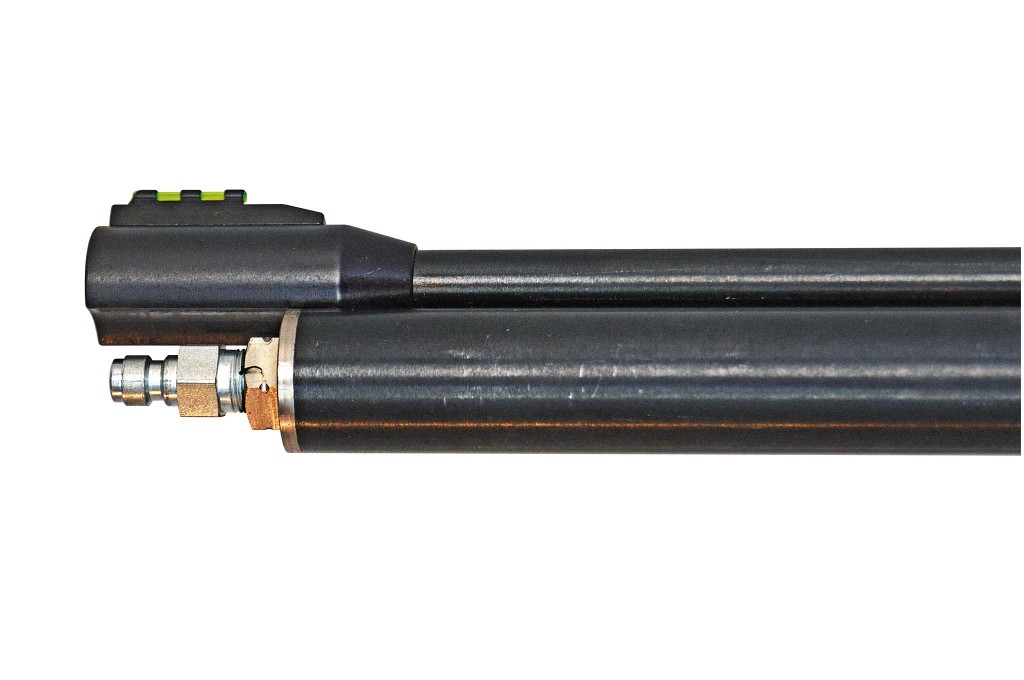
The Benjamin Discovery from Crosman is a pre-charged pneumatic rifle with a filling port just below the muzzle.
Let's get down to the nitty-gritty. Which type is the perfect survival airgun? It depends on your finances and circumstances.
If you can stretch your budget, a PCP would be a good bet. They are good for many high-powered shots, have low to no recoil, and are available from some manufacturers in large calibers (i.e. .25 and .30). Several models are adjustable for the power of the shot, which helps conserve air if full-power shots are not needed. Some models are fed by rotary magazines. As a bonus, suppressed models tend to have a mild sound signature, essential if you're trying to stay low-key. One manufacturer even makes a model with an interchangeable arrow-firing barrel. Some variants are carbine length, which adds to the appeal for some shooters.
The drawback? PCP versions can be pricey. For example, the Hatsan BT65 (featured in Issue 14 of our sister publication RECOIL) can fire 30 accurate shots at 30 yards before any noticeable drop in muzzle velocity — but it retails for about $700. Ouch! Other models, such as the Daystate Wolverine B, have a heart-attack-inducing MSRP of almost $2,000. Yes, two grand. Double ouch! Plus, if your bug-out truck doesn't already have an air compressor or you're forced to go on foot, you'll have a hard time justifying packing an air pump in your go-bag over, say, water and rations.
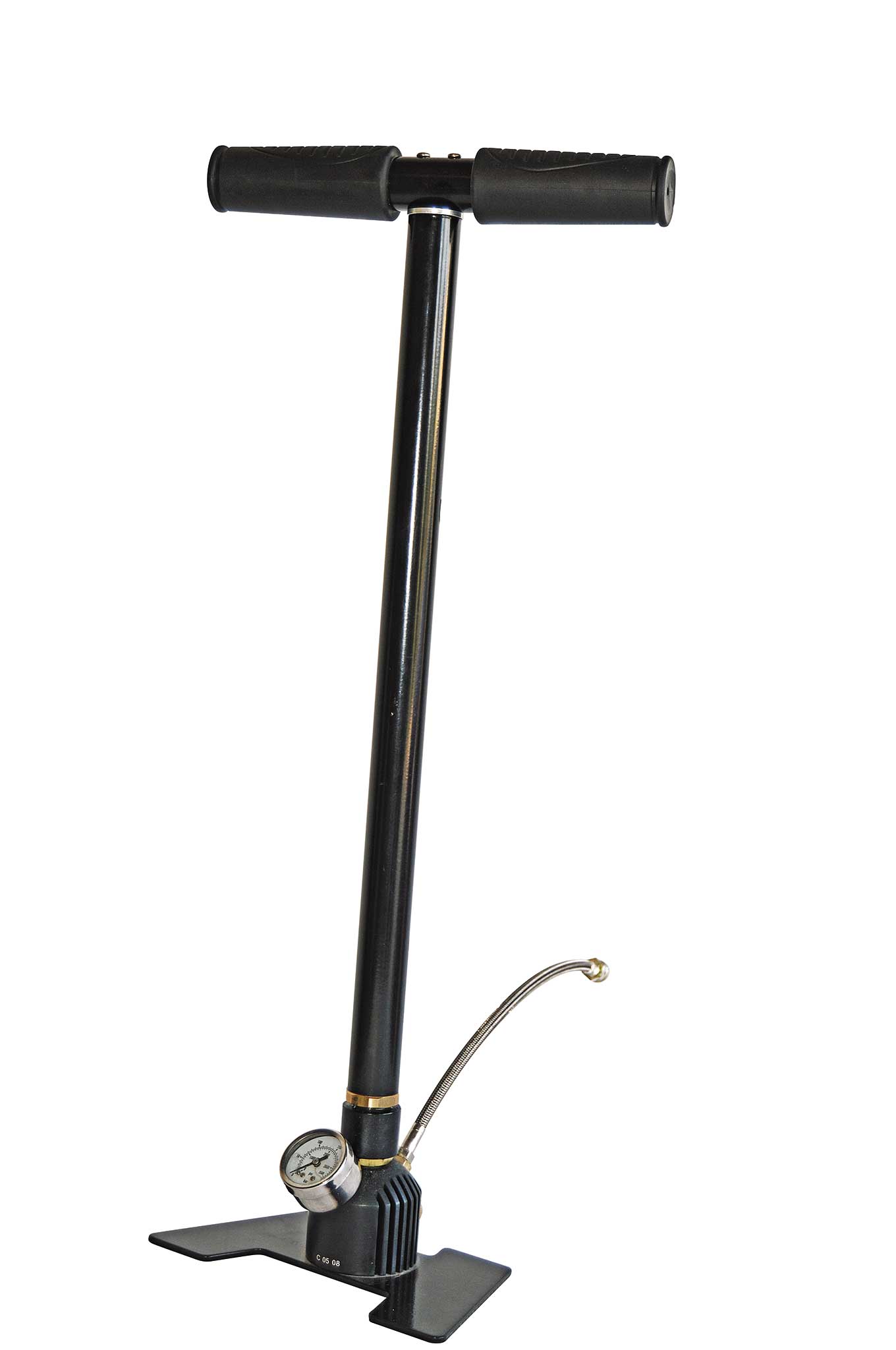
This special high-pressure air pump is designed to recharge pre-charged pneumatic (PCP) airguns. In a bug-out scenario,...
Another good choice for an off-grid airgun could be a multi-pump. These types truly are self-contained because the method to charge the gun is built right into the weapon itself. In .20- or .22-caliber, they are quite capable of taking small critters at reasonable distances. They tend to have light recoil and are relatively quiet. One manufacturer produces a bullpup configuration in .30-caliber and claims the pumping force doesn't increase with each pump. But there are downsides. They shouldn't be left pressurized for long periods. Plus, they must be pumped for each shot. So, if you're faced with more than one marauder or predator, you better make that first shot count and have a backup weapon at the ready.
For the budget-conscious, a break-barrel springer could be more than adequate as a survival gun. There are many models readily available in a myriad of calibers, stocks, and finishes. Some are very powerful, can be had in calibers as big as .25, and are accurate with practice. Models equipped with sound moderators reduce the sharp crack as the pellet leaves the barrel, and, of course, some work better than others.
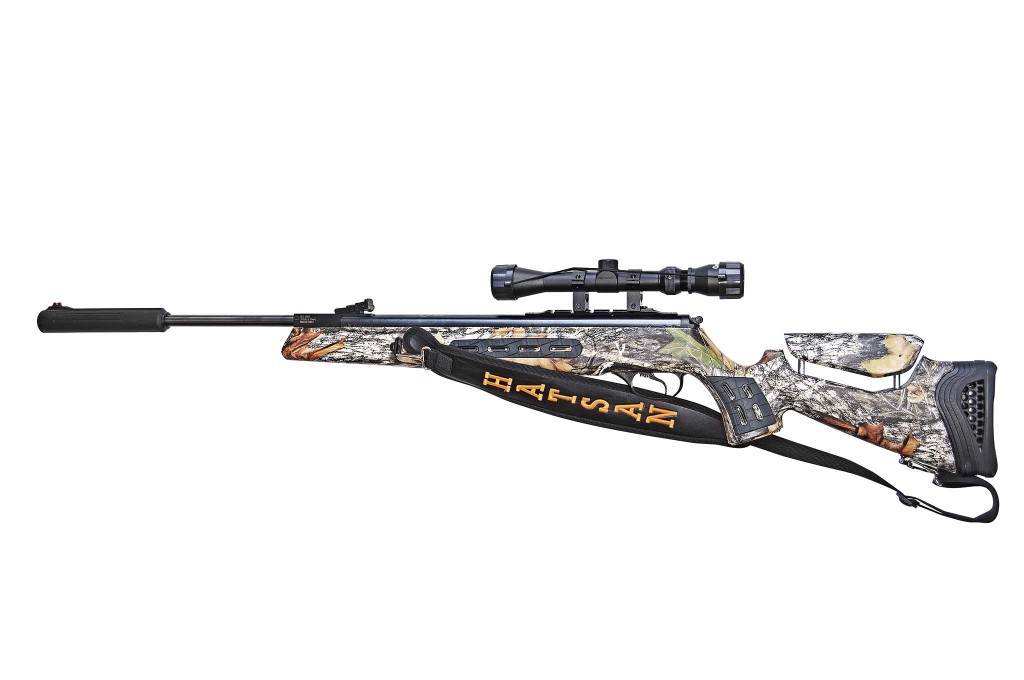
The Hatsan MOD 125 Sniper is available in .177, .22, and .25, the former of which can shoot up to 1,250 feet per...
What's their biggest hindrance as a SHTF tool? Springers are typically heavy due to the metal used in the receiver housing, its powerful spring, and a substantial stock to handle its internal stresses. If you're already carrying a large three-day pack, this type of airgun will only add to your cargo load. Also, they're rather loud unless fitted with a good suppressor. Its cocking force can be a bit much for smaller shooters, too. While not the same as a medium-caliber rifle, recoil from a springer can be surprisingly stout for shooters fondly remembering their old BB guns; plus, its recoil occurs in both forward and backward directions. For this reason, you do not want to use your favorite riflescope on your springer air rifle because it could eventually damage the scope.
Should you find yourself in a Red Dawn-like situation, your firearms will obviously be essential survival tools. But they're not always the best choice when you're forced to go on a stealth hunt after all the grocery stores have been boarded up, burned down, or taken over by unsavory types. Archery bows are great tools, but let's face it, they take a lot of practice to master and aren't necessarily the best choice with small game. Spears, slingshots, or blowguns might be an option at close range, but again, only with enough practice. For the area in between these options, the airgun makes sense for filling the void. There are a myriad of choices out there, so you are bound to find the right option for you. Do your research and test some out if you're able. It could mean the difference between facing starvation or putting meat in the pot.
Airguns aren't toys. Handle them like firearms, and obey the four cardinal safety rules: 1. Treat every gun as if it were loaded; 2. Always point the gun in a safe direction; 3. Keep your finger off the trigger until you're ready to fire; and 4. Be aware of your target's surroundings.
Keeping your weapons, even airguns, in top form is essential to your survival. For springer-type air rifles, besides cleaning and lubing the inside of the barrel occasionally, you'll want to oil its joints and any friction points. Any type of airgun you decide on will also need new O-rings or seals eventually. The seals will last a whole lot longer if you avoid using any products derived from petroleum distillates, so get yourself some quality silicone lubricant. Replacing seals on an airgun is a topic for another article, but educating yourself on some simple maintenance via the user manual, YouTube, or friends and acquiring a supply of seals and parts will go a long way in keeping that air rifle a viable piece of your survival kit.
Are you new to airguns? Never fired an air rifle before? Much like any other valuable survival tool, there is a bit of a learning curve. The best thing to do before purchasing a model is to do as much research as possible and test a few if you have the opportunity, then determine if any of them fit in your off-grid plans. Below is a brief list of companies and resources in the world of airguns.
Airforce Airguns: This U.S. manufacturer of pre-charge pneumatics (PCP) produces the Ton Jones signature survival air rifle.
www.airforceairguns.com
Airgun Hobbyist: A publication devoted to airguns and its related accessories.
www.airgunhobbyist.com
Airguns of Arizona: This importer and purveyor of fine airguns is also a certified repair facility for many brands.
www.airgunsofarizona.com
Crosman: Founded in 1923, this U.S. corporation makes all types of airguns, ammo, and accessories.
www.crosman.com
Daystate: An English company that constructs high-end PCP rifles.
www.daystate.com
FX Airguns: A Swedish maker of fine PCP and multi-pump air rifles, as well as the arrow-firing Verminator Extreme.
www.fxairguns.com
Gamo USA: This is the American arm of the longtime Spanish airgun manufacturer.
www.gamousa.com
Hatsan USA: The U.S. branch of a line of high-quality Turkish airguns, many in .25-caliber.
www.hatsanusa.com
Umarex USA: The American division of this German corporation designs impressive airguns.
www.umarexusa.com
 STAY SAFE: Download a Free copy of the OFFGRID Outbreak Issue
STAY SAFE: Download a Free copy of the OFFGRID Outbreak Issue
No Comments